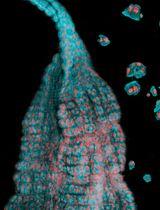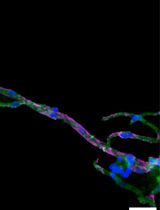- EN - English
- CN - 中文
Preparation of Mosquito Salivary Gland Extract and Intradermal Inoculation of Mice
蚊子唾液腺提取物的制备与小鼠真皮内接种
发布: 2017年07月20日第7卷第14期 DOI: 10.21769/BioProtoc.2407 浏览次数: 19149
评审: Alka MehraAnonymous reviewer(s)

相关实验方案

蚊虫和白蛉中肠组织的优化解离方法:用于高质量单细胞RNA测序
Ana Beatriz F. Barletta [...] Carolina Barillas-Mury
2025年06月20日 2321 阅读
Abstract
Mosquito-transmitted pathogens are among the leading causes of severe disease and death in humans. Components within the saliva of mosquito vectors facilitate blood feeding, modulate host responses, and allow efficient transmission of pathogens, such as Dengue, Zika, yellow fever, West Nile, Japanese encephalitis, and chikungunya viruses, as well as Plasmodium parasites, among others. Here, we describe standardized methods to assess the impact of mosquito-derived factors on immune responses and pathogenesis in mouse models of infection. This protocol includes the generation of mosquito salivary gland extracts and intradermal inoculation of mouse ears. Ultimately, the information obtained from using these techniques can help reveal fundamental mechanisms of interaction between pathogens, mosquito vectors, and the mammalian host. In addition, this protocol can help establish improved infection challenge models for pre-clinical testing of vaccines or therapeutics that take into account the natural route of transmission via mosquitoes.
Keywords: Mosquito (蚊子)Background
While probing for blood, the mosquito inoculates saliva that facilitates feeding but can also contain pathogens, if the mosquito has previously fed on an infected individual. Mosquito saliva plays an important role in establishing infection, facilitating dissemination, modulating immune responses, and exacerbating pathogenesis during West Nile virus (Schneider et al., 2006; Styer et al., 2011), Dengue virus (Cox et al., 2012; Conway et al., 2014; McCracken et al., 2014; Schmid et al., 2016), chikungunya virus (Agarwal et al., 2016), Semliki Forest virus (Pingen et al., 2016), Rift Valley Fever virus (Le Coupanec et al., 2013) and Plasmodium parasite (Schneider et al., 2011) infection. Many important questions yet remain and call for improved animal models.
Whereas inoculation via infected mosquitoes best mimics natural transmission, high variability in the inoculated dose and limited availability of insectary facilities result in restricted use of such procedures. In addition, the amount of saliva and the presence or absence of mosquito-derived components cannot be controlled when using infected mosquitoes. As an alternative, ‘spot feeding’ of uninfected female mosquitoes followed by intradermal inoculation of the pathogen via a needle mimics the natural deposition of saliva into mouse skin and delivers a defined dose of pathogen. The ‘spot feeding’ model has successfully been used to study Dengue virus (Cox et al., 2012; McCracken et al., 2014) and West Nile virus (Moser et al., 2015) infection but still requires the concomitant use of live mosquitoes and mice, and cannot control for the amount of saliva delivered. To separately control for mosquito and mouse experiments, inserting the mosquito proboscis into a sucrose solution in a capillary tube can serve to collect mosquito saliva artificially. The saliva collected during sugar feeding, however, differs qualitatively from mosquito saliva that is inoculated into the host skin during natural blood feeding (Marinotti et al., 1990; Moser et al., 2015).
Here, we describe the use of a simplified model of needle-inoculating mosquito salivary gland extract (SGE) from non-infected mosquitoes that can be delivered with a pathogen in a controlled manner at a defined dose. This method allows for independent handling of live mosquitoes and mice between collaborators and can more easily be standardized between assays and research groups. Use of SGE has proven useful to study infection with West Nile virus (Schneider et al., 2006; Moser et al., 2015), Dengue virus (Conway et al., 2014; Schmid et al., 2016), Rift Valley fever virus (Le Coupanec et al., 2013), and Sindbis virus (Schneider et al., 2004). Injection of SGE does not precisely mimic inoculation via the mosquito proboscis and likely contains non-secreted components of salivary glands. Nevertheless, this method allows collection of higher quantities of mosquito-derived factors, contains all secreted proteins, and can also be used in in vitro assays. Overall, the procedures described here should facilitate collaboration between entomologists, immunologists, and researchers studying pathogens of interest.
Materials and Reagents
Note: For the rearing of mosquitoes and general maintenance of a mosquito colony, see Bio-protocol Kauffman et al. (2017).
- Cotton-tipped swab, 15 cm handle (Puritan, catalog number: 25-826 5WC )
- Petri dish, sterile, 60 mm (e.g., 60 mm TC-Treated Cell Culture Dish, Corning, Falcon®, catalog number: 353002 )
- Plastic wrap
- 50-ml conical centrifuge tubes (CELLTREAT Scientific Products, catalog number: 229422 )
- 15-ml conical centrifuge tubes (CELLTREAT Scientific Products, catalog number: 229412 )
- 5-ml tubes, 12 x 75 mm (Corning, Falcon®, catalog number: 352054 )
- 96-well plates (Thermo Fisher Scientific, Thermo ScientificTM, catalog number: 15041 )
- 5-ml serological pipets (CELLTREAT Scientific Products, catalog number: 229206B )
- 10-ml serological pipets (CELLTREAT Scientific Products, catalog number: 229211B )
- Microcentrifuge tubes, 1.5 ml (Corning , Axygen®, catalog number: MCT-150-C )
- Needle: 30-gauge, small RN hub, custom-made, point style 4 (10°-12° bevel), 25-mm length (Hamilton, catalog number: 7803-07 )
Note: Alternative needles: use with disposable hypodermic needle, e.g., 30 G x 1 inch (BD, catalog number: 305128 ). - Frosted microscope slides, 25 x 75 x 1.0 mm (e.g., Fisher Scientific, catalog number: 12-550-343 )
- Wooden applicator sticks, 15 cm (Puritan, catalog number: 807 )
- Insect Pins Morpho Black enameled No.000 (BioQuip, catalog number: 1208B000 )
- Dissecting probes fabricated from wooden applicator sticks and insect pins
Note: Dissecting probes are fabricated from 15-cm wooden applicators and insect pins. Soak the applicator sticks in hot water for at least 30 min, and cut the heads off the pins and discard. Using plyers, hold the pin, avoiding damage to the pointy end, and push the blunt (cut) end into the stick. Let the probe dry. - Transfer pipets, 1 ml, bulk, nonsterile (BioLogix, catalog number: 30-0135 )
- pH test strips (e.g., Sigma-Aldrich, catalog number: P4536-100EA )
- Female mosquitoes
- Mosquito holding carton (see Bio-protocol Kauffman et al., 2017 for description and construction)
- Mice
- Triethylamine (Sigma-Aldrich, catalog number: T0866 )
- Ethyl alcohol
- Phosphate-buffered saline (PBS), low endotoxin ≤ 0.25 EU/ml (i.e., Mediatech, catalog number: 21-030-CV )
- Micro BCA Protein Assay Kit (Thermo Fisher Scientific, Thermo ScientificTM, catalog number: 23235 )
- Endpoint Chromogenic Limulus Amebocyte Lysate QCL-1000 Assay (Lonza, catalog number: 50-647U )
- Disinfectant, such as Bleach or Umonium38 (Huckert’s Laboratoire International, catalog number: PF 12209 )
- Isoflurane, Iso-Vet (Chanelle, catalog number: CDS019936 ) for anesthesia of mice
- 70% ethanol: Combine 74 ml of ethyl alcohol with 26 ml of water. Label as flammable and store at room temperature for up to 3 months
- Alexa Fluor 680
- Monoclonal antibody 4G2
Equipment
- Stir plate and stir bar
- Floating microtube rack (i.e., Thermo Fisher Scientific, Thermo ScientificTM, catalog number: 5974-4015 )
- Forceps, Superfine Tips, Swiss Style #5 (BioQuip, catalog number: 4535 )
- Cover slip forceps (Fisher Scientific, catalog number: S17328C )
Manufacturer: Medco Instruments, catalog number: S17328C .
Note: It is important that the flat parts of the forceps touch each other over the entire surface. If the opposing surfaces touch at only one point, the ear skin is more likely to generate folds when inserting the needle. - Stereoscopic Zoom Microscope (e.g., Nikon Instruments, model: SMZ1500 )
- Branson Sonifier Model 450 (Branson 450 Analog Sonifier with 1/2” Horn, 400 W, 120 VAC) (Cole-Parmer, catalog number: EW-04715-03 )
Manufacturer: Emerson Electric, BRANSON, model: Model 450 . - Cup Horn for Ultrasonic Processors, 3” dia (Cole-Parmer, catalog number: EW-04715-39)
Manufacturer: Emerson Electric, BRANSON, catalog number: 109-116-1760 . - Branson Sound-Proof Enclosure for Ultrasonic Processors (Cole-Parmer, catalog number: EW-04715-44)
Manufacturer: Emerson Electric, BRANSON, catalog number: 101-063-275 . - Refrigerated centrifuge (e.g., Eppendorf, model: 5417 R )
- Reusable glass microinjection syringe type 702RN, no needle, volume 25 µl (Hamilton, catalog number: 7636-01 )
Note: Alternative syringe: Reusable glass microinjection syringe model 702 LT (Luer tip), SYR, NDL sold separately, no needle, volume 25 µl (Hamilton, catalog number: 80401 ). - Heat block capable of heating to 37 °C and 60 °C (e.g., Digital Dry Block Heater, Single Block, 240 V, Thermo Fisher Scientific, Thermo ScientificTM, catalog number: 88870004 )
- Plate reader capable of reading absorption at 562 nm and 405-410 nm, and temperature control capable of heating to 37 °C (e.g., BioTek Instruments, model: ELx808 )
Procedure
文章信息
版权信息
© 2017 The Authors; exclusive licensee Bio-protocol LLC.
如何引用
Schmid, M. A., Kauffman, E., Payne, A., Harris, E. and Kramer, L. D. (2017). Preparation of Mosquito Salivary Gland Extract and Intradermal Inoculation of Mice. Bio-protocol 7(14): e2407. DOI: 10.21769/BioProtoc.2407.
分类
免疫学 > 动物模型 > 小鼠
微生物学 > 微生物-宿主相互作用 > 体内实验模型 > 原生动物
细胞生物学 > 组织分析 > 组织分离
您对这篇实验方法有问题吗?
在此处发布您的问题,我们将邀请本文作者来回答。同时,我们会将您的问题发布到Bio-protocol Exchange,以便寻求社区成员的帮助。
Share
Bluesky
X
Copy link












